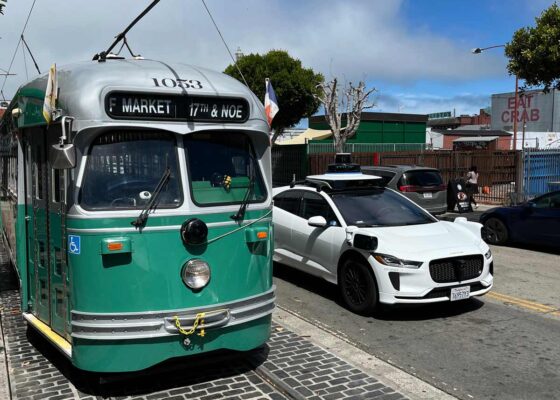Estimated Reading time: 7 minutes
Driverless Cars, renewed urban traffic concepts, new business models in and around mobility solutions – discussions about an autonomous future entail all of these vibrant topics, and so did our MaaS Conference in November 2019. Which are the challenges, cities and governments are facing? What technological solutions are already available, and which issues are vehicle manufacturers confronted with? Which role will data and data security take? What does autonomous driving entail for each individual and our everyday lives? And when and how will we get to the autonomous future?
Circling through ideas, thoughts, and knowledge regarding an autonomous future, we looked at it from various perspectives, that we will deep-dive into in our series: Opportunities & Challenges in the Autonomous future. During the next months we will start a hopefully vivid discussion with you, starting with the question: Is autonomous driving really ready for the street?
At accilium, working and living amidst techies and innovation all around us, there is no question to us whether or not people’s life will be changed tremendously by intelligent technologies. However, there are several challenges we are facing on our way to an autonomous future, both from a technological point of view, but also regarding societal acceptance, as well as political and regulatory issues such as liability.
We want to make you think about your own expectations towards an autonomous future, and – in advance – provide you with the most important perspectives, questions and challenges looking at the topic. Where did we get our knowledge from? First of all, we could gain first-hand insights from various experts in panel discussions and key notes at the 2019 Vienna MaaS-Conference. Another important source is academia – as you may have figured, this very broad topic has been subject to several studies and research, thus, comes with a variety of expert knowledge and well-established views.
Technological challenges: Today’s solutions are not yet as refined as we expected them to be.
Five years ago, large car manufacturers promised autonomous vehicles (AV) to be market ready in 2020. As time went by, it became evident, that these expectations had been too optimistic, and self-driving cars today find themselves on the trough of disillusionment of the Gartner Hype Cycle.
The unforeseen occurrence of the Corona virus in spring of 2020 put autonomous vehicles back into the center of discussion. With the rather strict legal and societal instructions to minimize contact to other humans, in order to decelerate the spread of the virus, self-driving cars were quickly named as a potential solution to transport and distribute goods and people, without putting service workers (mailmen, delivery drivers, taxi drivers etc.) at risk. And with this, the question arose, what actually would be technologically feasible in the short to long term.
The five levels of autonomous driving:
To get clear answers to this question, we should first specify the meaning of autonomous driving. Today, we distinguish between 5 levels of autonomy. While Level 1 has been industry standard for several years now (e.g. adaptive cruise control), Level 2 is available for most premium vehicles (e.g. adaptive cruise control + lane keeping assistant).
Level 3 systems, such as Audi’s Traffic Jam Pilot, which navigate the car fully automatically within a defined environment (divided highways, speed below 60 kmph), are technologically available today. However, there is currently no production car, which is sold anywhere in the world with Level 3 functionalities, due to missing regulatory approvals and liability concerns.
Level 4, which means that the vehicle does not require an active driver in any situation and can navigate under most conditions, is today available in experimental stages, e.g. by Alphabet’s Waymo. These vehicles are however not being sold and can only be operated with special authorization in limited areas. Vehicles with Level 4 capabilities require no safety driver and can therefore be used also by people with no license. While Level 4 vehicles are tested in certain areas around the globe by both established car manufacturers and new players, such as large tech companies and smaller startups, there can currently no exact statement be given, when those technologies will be fully functional under all environmental conditions (weather, road or traffic impediments) and available for consumers.
With the unmet expectations regarding the progress of autonomous vehicles it becomes evident, that there are several technological challenges, which AV companies are facing today.
Mapping, localizing, perceiving and planning in autonomous driving
Jen-Hsun Huang, the CEO of Nvidia, explains that the activities required for autonomous driving can be divided in four segments: mapping, localizing, perceiving and planning. Each activity faces its own challenges:
Mapping means, that the environment, in which the vehicle is operating, must be created as a digital 3D image with as many details as possible. This can be done by using existing data from maps and databases but must be validated in real time by the car’s sensors (mostly lidar, radar and cameras). The more volatile the environment is, the more complex it is for the vehicle to create a precise image. Therefore, Level 3 functionalities are in most cases meant for the use on highways, where each vehicle Mapping means, that the environment, in which the vehicle is operating, has to be created as a digital 3D image with as many details as possible. This can be done by using existing data from maps and databases but must be validated in real time by the car’s sensors (mostly lidar, radar and cameras). The more volatile the environment is, the more complex it becomes for the vehicle to create a precise image. Therefore, Level 3 functionalities are in most cases meant for the use on highways, where each vehicle has an own lane and interfering elements such as pedestrians or sudden road changes are less frequent.

Source: Self-driving car challenges obstacles, 07.07.2020
Localizing is the process, in which the car calculates its own position on the mapped environment. While moving (at possibly a high rate of speed) the vehicles needs to figure out, where it is within a few centimeters. Again, this is easy when the car is moving slowly, and all sensors work fine. But bad weather, signal interruptions or other interfering factors can impair a clear image and make it harder for the vehicle to find its own position.
Perceiving includes taking in and processing all information of the environment. This could be the behavior of other road users, traffic lights, signs. Not only must these inputs be processed in real time, but the car should also anticipate, how they are about to change in the near future. Will that traffic light change soon and will those pedestrians cross the street? This is especially difficult for machines, as people in most cases do not behave completely logically and predictably. In real life, communication between road users (driver to driver, driver to pedestrian etc.) happens through complex social interactions, such as body language, gestures or simply eye contact. Combined with cultural differences, this is hard for machines to understand.
Using all information of the Mapping, Localizing and Perceiving activities, the vehicle can then go on to the Planning activity and figure out its next step. Of course, the better and more consistent the input data is, the easier it gets for the vehicle to plan what to do. This is also the reason, why many companies operating test vehicles today are often limited to enclosed areas, such as hospitals, airports or certain streets and mostly operate solely under good weather conditions. Having more complex information makes it harder for the AV. “The computing capability necessary to achieve autonomy is far greater, than everything currently available” – Jen-Hsun Huang, at the 2016 CES. At the same time, it is important to secure all data flows against external perpetrators. Cyber security will become a major issue to ensure the safety of all road users.
Of course, with better hardware for sensors or control units and advanced machine learning, these are obstacles to overcome over time.
Technological issues are not the only challenge to overcome
Summing it up, car manufacturers still face several issues regarding the technology. Unexpectedly, the solutions we are provided with today are not as refined as experts expected them to be until a few years ago. However, most of the traditional manufacturers, as well as some promising start-ups and tech-companies are twisting their heads in order to enable our autonomous future. We can’t wait to see the latest and greatest solutions! Let us know what you think! How far away are we from an autonomous future – and are there any other technological impediments (or chances) we didn’t mention?
Coming up in our next article: More difficult than the sole technological issues may be other aspects. For a successful deployment, it will be crucial for AVs to get accepted by the society and not be obstructed by malicious intent of humans. Thus, we will discuss societal and regulatory challenges: Discussing autonomous driving is not only about what we can do technologically – we also need to think about, what we actually want to do!
Go to article Part II: How Can Self-Driving Cars Fit into our Society?
Go to article Part III: Robo cabs in the city center – a not too far away scenario









 ISO/IEC 27001:2013 certified
ISO/IEC 27001:2013 certified